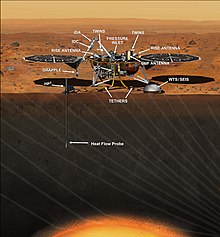NASA's InSight lander and MarCO craft launch in new mission to Mars
Monday, May 7, 2018

Image: Bill Ingalls, NASA.
On Saturday, United Launch Alliance launched a Atlas V 401 rocket carrying NASA's InSight Mars lander and two Mars Cube One (MarCO) miniature spacecraft known as cubesats. The pre-dawn launch from Vandenberg Air Force Base Space Launch Complex 3E in Lompoc, California was declared a success. This was the very first deep space launch from the west coast of the United States, and aimed to send a lander to the surface of the planet Mars to study its interior.
Launched alongside InSight were two MarCO cubesats, the first to be sent beyond Earth, nicknamed 'WALL-E' and 'Eve' after the protagonists of the 2008 animated science fiction film WALL-E. They were designed as a dual telecommunications relay for InSight during the spacecraft's descent through the Martian atmosphere.
Traditionally, NASA launched interplanetary spacecraft at Cape Canaveral Air Force Station in Florida on the United States' east coast. There, rockets were sent eastward over the Atlantic Ocean, borrowing the Earth's rotational velocity to shoot their payloads out into the solar system. Due to congestion on the launch calendar at Canaveral, NASA chose to launch the spacecraft from from Vandenberg Air Force Base on the country's west coast instead. A launch eastward from Vandenberg would have been dangerous due to densely populated areas being located downrange. Instead, rockets launched from Vandenberg were sent in a south-southeast trajectory. For Insight and MarCO, the spacecraft was placed in a temporary polar orbit after the launch, with the pair being shot towards Mars during a escape burn performed over the North Pole.
Despite a heavy fog settling in at the rocket's launch pad in Lompoc, the United Launch Alliance declared a "100% chance of favorable weather for liftoff". Spectators in Lompoc were treated to a mostly obscured view of the launch, though they were witness nonetheless to the sound and shock waves of the Atlas V's Common Core first stage as it lifted the spacecraft off the ground on-schedule at 4:05 PDT (1105 UTC). People along the coast of southern California and northern Baja California, however, were in clear view of the Atlas V's main engine burn and the first burn of the rocket's Centaur upper stage. People in Orange County, California were treated to the sight of InSight and the Centaur almost eclipsing the planet Jupiter in the night sky.

Image: NASA/JPL.
The recently-inaugurated Administrator of NASA, Jim Bridenstine, congratulated the InSight team in an address televised live on NASA TV after the launch, along with the United Launch Alliance on what was their 128th successful launch in a row. The InSight mission part of NASA's Discovery program, a class of low-cost solar system exploration missions. It was selected to launch in the program after beating the Comet Hopper and Titan Mare Explorer proposals amongst responses to a 2010 request.
Both InSight and the MarCO cubesats are en route to Mars. InSight carries eight scientific instruments, including a seismometer known as Seismic Experiment for Interior Structure (SEIS). The SEIS instrument will be recording the very first seismic measurements of Mars, which scientists hope will shed light on the structure of Mars beneath its surface. The lander was equipped with two cameras, based on the architecture of the Mars Exploration Rover's navigation camera and hazard avoidance camera, to allow mission scientists to monitor the activity of the instruments. NASA scheduled a November 26 landing for InSight on a broad plain in the planet's northern hemisphere, known as Elysium Planitia.
Sources
- Stephen Clark. "After foggy departure, it’s clear sailing to Mars for InSight lander" — Spaceflight Now, May 5, 2018
- AP. "NASA Launches InSight Spacecraft to Mars to Dig Down Deep" — The New York Times, May 5, 2018
- Jeff Foust. "Atlas 5 launches NASA InSight Mars lander" — SpaceNews, May 5, 2018
- Jim Bridenstine. "I’m grateful to our many partners" — Twitter, May 5, 2018 (Video)
- Gene Blevins. "First NASA lander to study Mars' interior launches from California" — Reuters, May 5, 2018
- Stephen Clark. "All systems go for launch of InSight, a mission to reveal the inside of Mars" — Spaceflight Now, May 4, 2018
- Elizabeth Howell. "NASA's Mars Cubesats 'Wall-E' and 'Eva' Will Be First at Another Planet" — Space.com, May 1, 2018
- Emily Lakdawalla. "Meet InSight: The Mission To Measure Marsquakes and Unlock the Red Planet" — Popular Mechanics, April 30, 2018
- Dwayne C. Brown. "NASA Selects Investigations For Future Key Planetary Mission" — NASA, May 5, 2011


